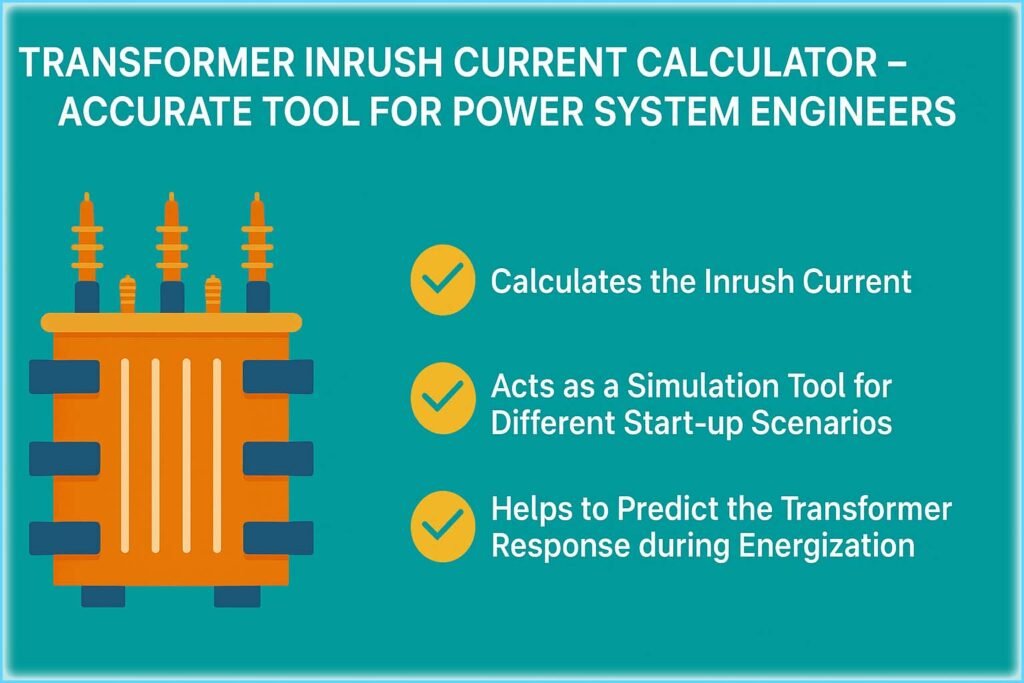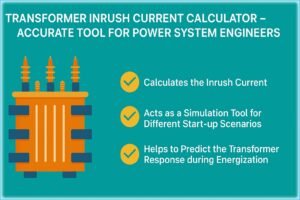Transformer Inrush Current Calculator – Accurate Tool for Power System Engineers
When a transformer is energized, it doesn’t always behave as expected. Sometimes, it draws a huge surge of current — many times higher than its rated value. This sudden spike is called inrush current, and it can cause nuisance tripping, mechanical stress, or even insulation failure if not properly understood or managed. That’s where a Transformer Inrush Current Calculator becomes invaluable.
A transformer inrush current calculator helps engineers, technicians, and students estimate the peak magnetizing current at the instant of energization. This makes it easier to design protection schemes, choose suitable circuit breakers, and understand transformer behavior under different conditions.

Table of Contents
Transformers are critical in power systems, but their transient response during energization can be tricky to predict. Inrush current depends on multiple parameters like core saturation, residual flux, switching angle, and system impedance. Manually calculating it can be tedious, which is why using an online Transformer Inrush Current Calculator simplifies the entire process.
Key Takeaways
- Transformer Inrush Current Calculator estimates the peak current drawn when a transformer is first energized.
- It helps prevent nuisance tripping and ensures the correct relay and circuit breaker sizing.
- The inrush current can be 5 to 10 times higher than the full-load current depending on core conditions.
- Using an inrush current calculator enhances system reliability and design accuracy.
Transformer Inrush Current
When a transformer is switched on, the magnetic core flux doesn’t start at zero. If residual magnetism is present, or if switching occurs at a voltage peak, the magnetic core may enter deep saturation. This causes a high magnetizing current to flow through the windings.
Transformer Inrush Current Calculator
Estimate peak inrush current based on transformer rating, voltage, core material, and energization conditions.
The magnitude and duration of this current depend on:
- Core material and design
- Supply voltage waveform
- Residual flux in the core
- Point-on-wave of energization
- System source impedance
A Transformer Inrush Current Calculator takes these parameters into account and provides an estimated value of the initial current peak. This helps engineers visualize transient behavior without needing simulation software like PSCAD or MATLAB.
Use our online tool Single Phase Transformer Calculator – Accurate Transformer Sizing & Efficiency Tool
Why You Need a Transformer Inrush Current Calculator
Estimating inrush current manually involves complex magnetic and electrical equations. For instance, inrush current can reach 10 to 15 times the rated current in large distribution or power transformers. These high currents can:
- Cause false tripping in protective relays.
- Lead to voltage dips affecting nearby equipment.
- Generate mechanical stress in transformer windings.
By using a Transformer Inrush Current Calculator, you can quickly predict whether the selected circuit breaker, relay, or fuse can handle the energization surge safely. It’s a practical tool for engineers during transformer design, testing, and field commissioning.
Formula Behind Transformer Inrush Current Calculator
Although actual inrush behavior is nonlinear, an approximate formula used in calculations is:
Inrush Current (I_inrush) = K × I_rated × (1 – e^(-t/τ))
Where:
| Symbol | Description | Typical Value |
|---|---|---|
| K | Inrush factor (depends on saturation) | 5 to 15 |
| I_rated | Rated full-load current | Calculated from transformer rating |
| t | Time after energization (seconds) | 0 – 0.5 s |
| τ (tau) | Time constant of magnetic circuit | 0.01 – 0.1 s |
This equation gives an approximate waveform of the inrush current decay over time. A Transformer Inrush Current Calculator applies this or a similar algorithm automatically — saving time and ensuring accuracy.
Use our online tool EV Charger Energy Usage Cost Calculator
Example: Inrush Current Estimation
Let’s take a simple example. Suppose we have a 100 kVA, 11 kV/433 V transformer.
- Rated Current (LV Side):
I = (100 × 1000) / (√3 × 433) = 133.3 A - Assuming K = 8 (core saturation factor)
Inrush Current = 8 × 133.3 = 1066.4 A
That means the transformer may draw around 1066 A instantaneously at energization. A Transformer Inrush Current Calculator provides this result instantly without manual computation.
| Parameter | Value | Unit |
|---|---|---|
| Transformer Rating | 100 | kVA |
| LV Voltage | 433 | V |
| Rated Current | 133.3 | A |
| Inrush Factor (K) | 8 | — |
| Inrush Current | 1066.4 | A |
How the Transformer Inrush Current Calculator Works
Your Transformer Inrush Current Calculator works by combining theoretical modeling and user inputs. The user enters transformer parameters like:
- Transformer rating (kVA)
- Primary and secondary voltages
- Type of transformer (core or shell)
- Core material or inrush coefficient (K)
The calculator processes these inputs and outputs:
- Peak inrush current (A)
- Percentage of rated current
- Duration of transient current decay
This helps in protection coordination, especially when setting overcurrent relays or differential protection schemes.
Factors Affecting Transformer Inrush Current
Even small design or operational changes can significantly affect inrush current magnitude. Key influencing factors include:
1. Residual Flux:
If residual magnetism remains in the core, the new flux can add to it during energization, causing saturation.
2. Switching Angle:
If the transformer is switched on when supply voltage is at its maximum, flux peaks instantly, creating large inrush.
Use our online tool EV Charger Load Calculation Tool – Accurate Power Estimation for Home and Commercial EV Chargers
3. System Impedance:
A system with high impedance limits inrush current, while a strong grid (low impedance) allows higher peaks.
4. Transformer Design:
Core type, lamination thickness, and winding configuration all influence inrush magnitude.
5. Temperature and History:
Core temperature and previous operating conditions affect magnetic properties and residual flux.
A Transformer Inrush Current Calculator can model these effects using empirical data and user inputs.
Applications of Transformer Inrush Current Calculation
Knowing the inrush current value is critical in multiple power engineering applications:
- Relay Coordination: Setting the differential or overcurrent relays correctly to avoid false trips.
- Circuit Breaker Selection: Ensuring breaker capacity can handle transient surges.
- Transformer Testing: Predicting magnetizing current waveform during factory or field tests.
- Protection System Design: Designing inrush restraints in differential protection schemes.
- Power Quality Analysis: Understanding voltage dips during transformer energization.
For these purposes, an easy-to-use Transformer Inrush Current Calculator provides fast, reliable results that improve system reliability.
Advantages of Using Transformer Inrush Current Calculator
Using a calculator instead of manual computation brings several benefits:
- Saves Time: Instant calculations for multiple transformer sizes.
- Improves Accuracy: Reduces human error and complex derivations.
- Enhances Safety: Prevents breaker miscoordination and equipment damage.
- Optimizes Design: Helps in selecting correct CT ratios and relay settings.
- User-Friendly: Works online with simple inputs and clear outputs.
These advantages make it an essential tool for every electrical engineer and technician working with transformers.
Use our online tool Inverter Size Calculator VA Rating by Load – Find the Perfect Inverter for Your Home or Office
Common Myths About Inrush Current
Some believe that inrush current only happens in large transformers — that’s not true. Even small distribution transformers experience transient magnetizing currents. Another misconception is that inrush lasts for several seconds; in reality, it typically decays within 0.3–0.5 seconds.
The Transformer Inrush Current Calculator helps dispel these myths by giving accurate, data-driven results for any transformer size or voltage level.
Tips to Reduce Transformer Inrush Current
While calculation is important, engineers also try to minimize inrush in practical systems. Common strategies include:
- Controlled Switching Devices: Closing breakers at specific voltage angles.
- Pre-insertion Resistors: Limiting surge current through resistive elements.
- Residual Flux Control: Ensuring the core is demagnetized before energization.
- Sequential Energization: Energizing transformers one phase at a time.
By knowing the expected inrush current from your Transformer Inrush Current Calculator, you can choose the right mitigation technique.
Use our online tool Solar Panel Size Calculator by Load – Find the Right System for Your Power Needs
Conclusion
Understanding transformer inrush current is vital for reliable power system design and protection. The Transformer Inrush Current Calculator simplifies this process by providing quick, accurate results that otherwise require complex analysis.
Whether you are an electrical engineer, protection specialist, or student, this calculator is a must-have tool. It helps design safer systems, choose correct protection settings, and ensure stable transformer operation during energization.
With this calculator, you gain confidence in your transformer’s performance and can make informed decisions backed by real data. Try the Transformer Inrush Current Calculator today and experience precision and simplicity in transformer analysis like never before.
Follow Us on Social:
Subscribe our Newsletter on Electrical Insights to get the latest updates in Electrical Engineering.
#TransformerInrushCurrentCalculator, #TransformerProtection, #PowerSystemEngineering, #ElectricalEngineering, #InrushCurrent, #TransformerDesign, #PowerSystemAnalysis, #CurrentCalculation, #ElectricalSafety, #TransformerTesting, #EnergyEngineering, #TransformerStartup, #RelayProtection, #EngineeringTools, #SmartGridTechnology
Transformer Inrush Current Calculator – Accurate Tool for Power System Engineers : Electrical Engineering Hub

Use our Transformer Inrush Current Calculator to estimate magnetizing inrush current precisely. Designed for power system engineers, this tool helps analyze transformer startup behavior, ensuring accurate protection and reliable system performance
Price Currency: USD
Operating System: All
Application Category: Web Application
